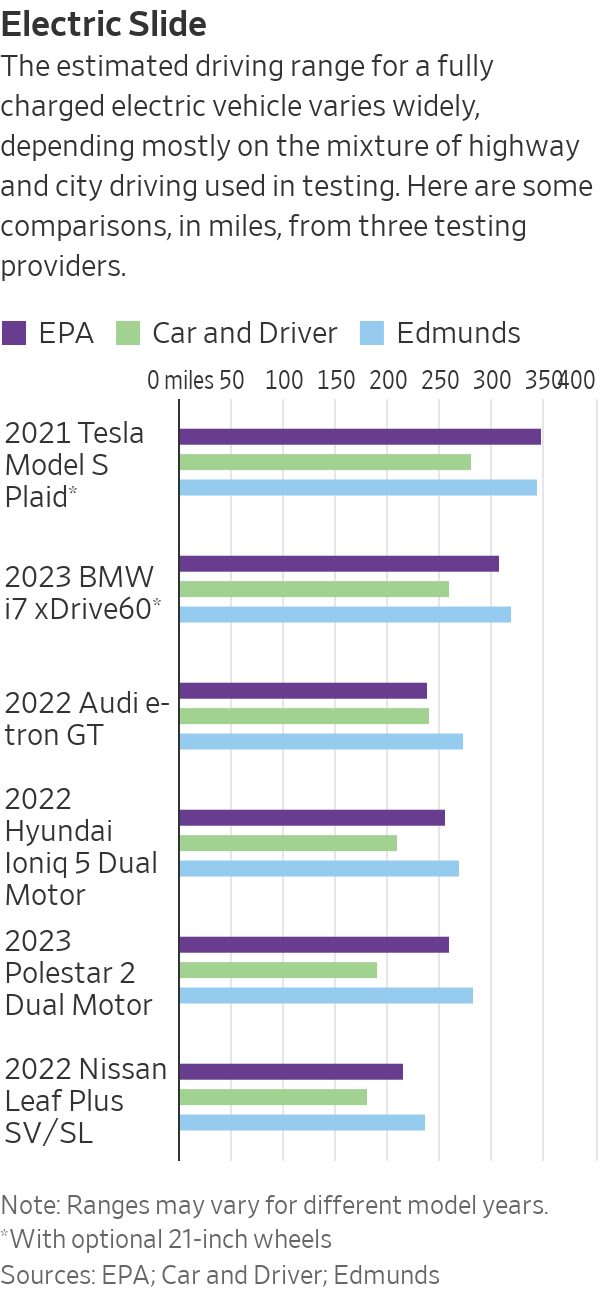Electric Cars and Driving Range: Here’s What to Know
How far can an electric car really go on a full charge? What can you do to make it go farther? We answer these and other questions that EV buyers might ask.
Many people considering an electric vehicle are turned off by their prices or the paucity of public charging stations. But the biggest roadblock often is “range anxiety”—the fear of getting stuck on a desolate road with a dead battery.
All EVs carry window stickers stating how far they should go on a full charge. Yet these range estimates—overseen by the Environmental Protection Agency and touted in carmakers’ ads—can be wrong in either direction: either overstating or understating the distance that can be driven, sometimes by 25% or more.
How can that be? Below are questions and answers about how driving ranges are calculated, what factors affect the range, and things EV owners can do to go farther on a charge.
How far will an electric vehicle go on a full battery?
The distance, according to EPA testing, ranges from 516 miles for the 2023 Lucid Air Grand Touring with 19-inch wheels to 100 miles for the 2023 Mazda MX-30.
Most EVs are in the 200-to-300-mile range. While that is less than the distance that many gasoline-engine cars can go on a full tank, it makes them suitable for most people’s daily driving and medium-size trips. Yet it can complicate longer journeys, especially since public chargers can be far apart, occupied or out of service. Plus, it takes many times longer to charge an EV than to fill a tank with gas.
How accurate are the EPA range estimates?
Testing by Car and Driver magazine found that few vehicles go as far as the EPA stickers say. On average, the distance was 12.5% shorter, according to the peer-reviewed study distributed by SAE International, formerly the Society of Automotive Engineers.
In some cases, the estimates were further off: The driving range of Teslas fell below their EPA estimate by 26% on average, the greatest shortfall of any EV brand the magazine tested. Separately, federal prosecutors have sought information about the driving range of Teslas, The Wall Street Journal reported. Tesla didn’t respond to a request for comment.
The study also said Ford’s F-150 Lightning pickup truck went 230 miles compared with the EPA’s 300-mile estimate, while the Chevrolet Bolt EV went 220 miles versus the EPA’s 259.
A GM spokesman said that “actual range may vary based on several factors, including things like temperature, terrain/road type, battery age, loading, use and maintenance.” Ford said in a statement that “the EPA [figure] is a standard. Real-world range is affected by many factors, including driving style, weather, temperature and if the battery has been preconditioned.”
Meanwhile, testing by the car-shopping site Edmunds found that most vehicles beat their EPA estimates. It said the Ford Lightning went 332 miles on a charge, while the Chevy Bolt went 265 miles.

That is confusing. How can the test results vary so much?
Driving range depends largely on the mixture of highway and city roads used for testing. Unlike gasoline-powered cars, EVs are more efficient in stop-and-go driving because slowing down recharges their batteries through a process called regenerative braking. Conversely, traveling at a high speed can eat up a battery’s power faster, while many gas-engine cars meet or exceed their EPA highway miles-per-gallon figure.
What types of driving situations do the various tests use?
Car and Driver uses only highway driving to see how far an EV will go at a steady 75 mph before running out of juice. Edmunds uses a mix of 60% city driving and 40% highway. The EPA test, performed on a treadmill, simulates a mixture of 55% highway driving and 45% city streets.
What’s the reasoning behind the different testing methods?
Edmunds believes the high proportion of city driving it uses is more representative of typical EV owners, says Jonathan Elfalan, Edmunds’s director of vehicle testing. “Most of the driving [in an EV] isn’t going to be road-tripping but driving around town,” he says.
Car and Driver, conversely, says its all-highway testing is deliberately more taxing than the EPA method. High-speed interstate driving “really isn’t covered by the EPA’s methodology,” says Dave VanderWerp, the magazine’s testing director. “Even for people driving modest highway commutes, we think they’d want to know that their car could get 20%-30% less range than stated on the window sticker.”
What does the EPA say about the accuracy of its range figures?
The agency declined to make a representative available to comment, but said in a statement: “Just like there are variations in EPA’s fuel-economy label [for gas-engine cars] and people’s actual experience on the road for a given make and model of cars/SUVs, BEV [battery electric vehicle] range can exceed or fall short of the label value.”
What should an EV shopper do with these contradictory range estimates?
Pick the one based on the testing method that you think matches how you generally will drive, highway versus city. When shopping for a car, be sure to compare apples to apples—don’t, for instance, compare the EPA range estimate for one vehicle with the Edmunds one for another. And view all these figures with skepticism. The estimates are just that.
Since range is so important to many EV buyers, why don’t carmakers simply add more batteries to provide greater driving distance?
Batteries are heavy and are the most expensive component in an EV, making up some 30% of the overall vehicle cost. Adding more could cut into a vehicle’s profit margin while the added weight means yet more battery power would be used to move the car.
But battery costs have declined over the past 10 years and are expected to continue to fall, while new battery technologies likely will increase their storage capacity. Already, some of the newest EV models can store more power at similar sticker prices to older ones.
What can an EV owner do to increase driving range?
The easiest thing is to slow down. High speeds eat up battery life faster. Traveling at 80 miles an hour instead of 65 can cut the driving range by 17%, according to testing by Geotab, a Canadian transportation-data company. And though a primal appeal of EVs is their zippy takeoff, hard acceleration depletes a battery much quicker than gentle acceleration.
Does cold weather lower the driving range?
It does, and sometimes by a great amount. The batteries are used to heat the car’s interior—there is no engine creating heat as a byproduct as in a gasoline car. And many EVs also use electricity to heat the batteries themselves, since cold can deteriorate the chemical reaction that produces power.
Testing by Consumer Reports found that driving in 15- to-20-degrees Fahrenheit weather at 70 mph can reduce range by about 25% compared to similar-speed driving in 65 degrees.
A series of short cold-weather trips degraded the range even more. Consumer Reports drove two EVs 40 miles each in 20-degree air, then cooled them off before starting again on another 40-mile drive. The cold car interiors were warmed by the heater at the start of each of three such drives. The result: range dropped by about 50%.
Does air conditioning degrade range?
Testing by Consumer Reports and others has found that using the AC has a much lower impact on battery range than cold weather, though that effect seems to increase in heat above 85 degrees.
I don’t want to freeze or bake in my car to get more mileage. What can I do?
“Precondition” your EV before driving off, says Alex Knizek, manager of automotive testing and insights at Consumer Reports. In other words, chill or heat it while it is still plugged in to a charger at home or work rather than using battery power on the road to do so. In the winter, turn on the seat heaters, which many EVs have, so you be comfortable even if you keep the cabin temperature lower. In the summer, try to park in the shade.
What about the impact from driving in a mountainous area?
Going up hills takes more power, so yes, it drains the battery faster, though EVs have an advantage over gas vehicles in that braking on the downside of hills returns juice to the batteries with regenerative braking.
Are there other factors that can affect range?
Tires play a role. Beefy all-terrain tires can eat up more electricity than standard ones, as can larger-diameter ones. And underinflated tires create more rolling resistance, and so help drain the batteries.
Most EVs give the remaining driving range on a dashboard screen. Are these projections accurate?
The meters are supposed to take into account your speed, outside temperature and other factors to keep you apprised in real time of how much farther you can travel. But EV owners and car-magazine testers complain that these “distance to empty” gauges can suddenly drop precipitously if you go from urban driving to a high-speed highway, or enter mountainous territory.
So be careful about overly relying on these gauges and take advantage of opportunities to top off your battery during a multihour trip. These stops could be as short as 10 or 15 minutes during a bathroom or coffee break, if you can find a high-powered DC charger.
Before embarking on a long trip, what should an EV owner do?
Fully charge the car at home before departing. This sounds obvious but can be controversial, since many experts say that routinely charging past 80% of a battery’s capacity can shorten its life. But they also say that charging to 100% occasionally won’t do damage. Moreover, plan your charging stops in advance to ease the I-might-run-out panic.
So battery life is an issue with EVs, just as with smartphones?
Yes, an EV battery’s ability to fully charge will degrade with use and age, likely leading to shorter driving range. Living in a hot area also plays a role. The federal government requires an eight-year/100,000-mile warranty on EV batteries for serious failure, while some EV makers go further and cover degradation of charging capacity. Replacing a bad battery costs many thousands of dollars.
What tools are available to map out charging stations?
Your EV likely provides software on the navigation screen as well as a phone app that show charging stations. Google and Apple maps provide a similar service, as do apps and websites of charging-station networks.
But always have a backup stop in mind—you might arrive at a charging station and find that cars are lined up waiting or that some of the chargers are broken. Damaged or dysfunctional chargers have been a continuing issue for the industry.
Any more tips?
Be sure to carry a portable charger with you—as a last resort you could plug it into any 120-volt outlet to get a dribble of juice.
 Copyright 2020, Dow Jones & Company, Inc. All Rights Reserved Worldwide. LEARN MORE
Copyright 2020, Dow Jones & Company, Inc. All Rights Reserved Worldwide. LEARN MORE
This stylish family home combines a classic palette and finishes with a flexible floorplan
Just 55 minutes from Sydney, make this your creative getaway located in the majestic Hawkesbury region.
As Paris makes its final preparations for the Olympic games, its residents are busy with their own—packing their suitcases, confirming their reservations, and getting out of town.
Worried about the hordes of crowds and overall chaos the Olympics could bring, Parisians are fleeing the city in droves and inundating resort cities around the country. Hotels and holiday rentals in some of France’s most popular vacation destinations—from the French Riviera in the south to the beaches of Normandy in the north—say they are expecting massive crowds this year in advance of the Olympics. The games will run from July 26-Aug. 1.
“It’s already a major holiday season for us, and beyond that, we have the Olympics,” says Stéphane Personeni, general manager of the Lily of the Valley hotel in Saint Tropez. “People began booking early this year.”
Personeni’s hotel typically has no issues filling its rooms each summer—by May of each year, the luxury hotel typically finds itself completely booked out for the months of July and August. But this year, the 53-room hotel began filling up for summer reservations in February.
“We told our regular guests that everything—hotels, apartments, villas—are going to be hard to find this summer,” Personeni says. His neighbours around Saint Tropez say they’re similarly booked up.
As of March, the online marketplace Gens de Confiance (“Trusted People”), saw a 50% increase in reservations from Parisians seeking vacation rentals outside the capital during the Olympics.
Already, August is a popular vacation time for the French. With a minimum of five weeks of vacation mandated by law, many decide to take the entire month off, renting out villas in beachside destinations for longer periods.
But beyond the typical August travel, the Olympics are having a real impact, says Bertille Marchal, a spokesperson for Gens de Confiance.
“We’ve seen nearly three times more reservations for the dates of the Olympics than the following two weeks,” Marchal says. “The increase is definitely linked to the Olympic Games.”

Getty Images
According to the site, the most sought-out vacation destinations are Morbihan and Loire-Atlantique, a seaside region in the northwest; le Var, a coastal area within the southeast of France along the Côte d’Azur; and the island of Corsica in the Mediterranean.
Meanwhile, the Olympics haven’t necessarily been a boon to foreign tourism in the country. Many tourists who might have otherwise come to France are avoiding it this year in favour of other European capitals. In Paris, demand for stays at high-end hotels has collapsed, with bookings down 50% in July compared to last year, according to UMIH Prestige, which represents hotels charging at least €800 ($865) a night for rooms.
Earlier this year, high-end restaurants and concierges said the Olympics might even be an opportunity to score a hard-get-seat at the city’s fine dining.
In the Occitanie region in southwest France, the overall number of reservations this summer hasn’t changed much from last year, says Vincent Gare, president of the regional tourism committee there.
“But looking further at the numbers, we do see an increase in the clientele coming from the Paris region,” Gare told Le Figaro, noting that the increase in reservations has fallen directly on the dates of the Olympic games.
Michel Barré, a retiree living in Paris’s Le Marais neighbourhood, is one of those opting for the beach rather than the opening ceremony. In January, he booked a stay in Normandy for two weeks.
“Even though it’s a major European capital, Paris is still a small city—it’s a massive effort to host all of these events,” Barré says. “The Olympics are going to be a mess.”
More than anything, he just wants some calm after an event-filled summer in Paris, which just before the Olympics experienced the drama of a snap election called by Macron.
“It’s been a hectic summer here,” he says.

AFP via Getty Images
Parisians—Barré included—feel that the city, by over-catering to its tourists, is driving out many residents.
Parts of the Seine—usually one of the most popular summertime hangout spots —have been closed off for weeks as the city installs bleachers and Olympics signage. In certain neighbourhoods, residents will need to scan a QR code with police to access their own apartments. And from the Olympics to Sept. 8, Paris is nearly doubling the price of transit tickets from €2.15 to €4 per ride.
The city’s clear willingness to capitalise on its tourists has motivated some residents to do the same. In March, the number of active Airbnb listings in Paris reached an all-time high as hosts rushed to list their apartments. Listings grew 40% from the same time last year, according to the company.
With their regular clients taking off, Parisian restaurants and merchants are complaining that business is down.
“Are there any Parisians left in Paris?” Alaine Fontaine, president of the restaurant industry association, told the radio station Franceinfo on Sunday. “For the last three weeks, there haven’t been any here.”
Still, for all the talk of those leaving, there are plenty who have decided to stick around.
Jay Swanson, an American expat and YouTuber, can’t imagine leaving during the Olympics—he secured his tickets to see ping pong and volleyball last year. He’s also less concerned about the crowds and road closures than others, having just put together a series of videos explaining how to navigate Paris during the games.
“It’s been 100 years since the Games came to Paris; when else will we get a chance to host the world like this?” Swanson says. “So many Parisians are leaving and tourism is down, so not only will it be quiet but the only people left will be here for a party.”
This stylish family home combines a classic palette and finishes with a flexible floorplan
Just 55 minutes from Sydney, make this your creative getaway located in the majestic Hawkesbury region.






















